- You are here:
- Home »
- General Coaching
Category Archives for General Coaching
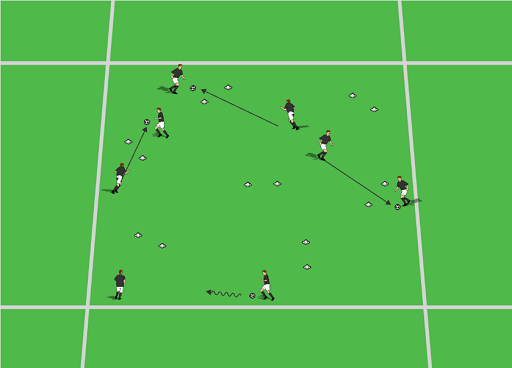
Diamond Passing Drill
By Arthur Bell –
Setup:
10 – 16 players – working in a 20 x 20 area.
4 Cones.
Supply of balls.
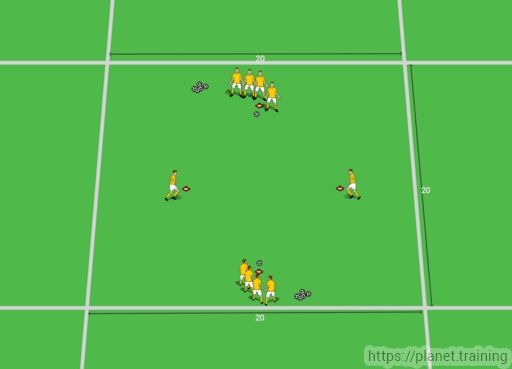
Execution:
The ball is passed round the diamond.
Players follow their own pass.
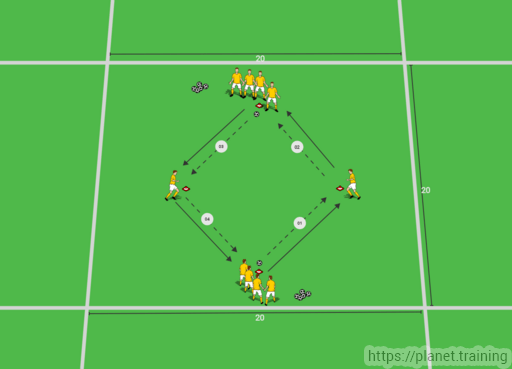
Variations:
1. A1 passes to B1 and then runs to B1’s position.
B1 passes to C1 and follows his pass.
C1 passes to A1 and follows his pass.
A1 receives, passes to D1 and then follows his pass.
D1 repeats the sequence on the other side by passing to B2.
Players at B and C should be replaced at regular intervals.
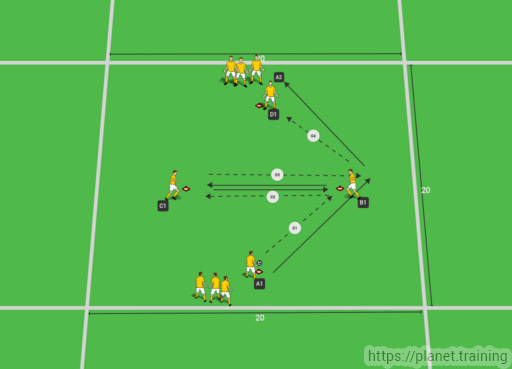
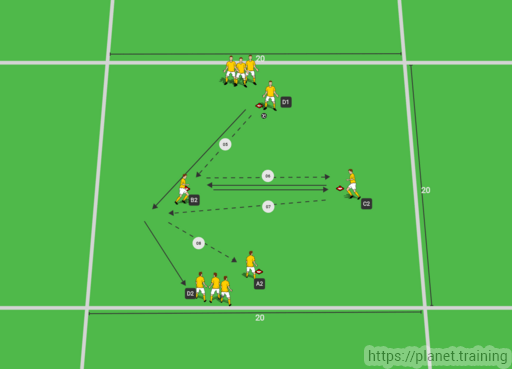
2. A1 passes to B1 and then runs towards B1’s position.
B1 lays off the ball to A1 and goes to B2.
A1 receives then passes to D1 and follows his pass to A2.
D1 repeats the sequence on the other side by passing to C1.
Players at B and C should be replaced at regular intervals.
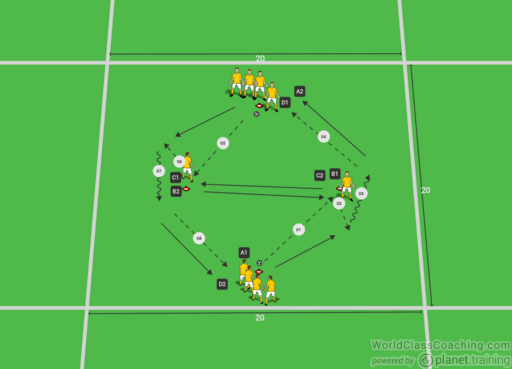
3. Repeat the sequences with two balls, one starting at A and the other starting at D simultaneously.
4. Repeat the sequences with a maximum of two touches each.
5. Repeat the sequences one touch.
6. Repeat the sequences with the ball kept in the air.

By Arthur Bell
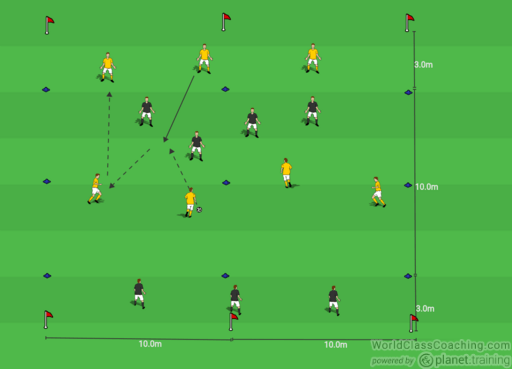
1 and 2 Touch Combination Play
By Arthur Bell –
Setup:
14 players – 7 Black, 7 Yellow working in a 30 x 30 area.
3 End Zone players for each team.
4 v 4 in the central area.
Area should be age and stage appropriate, example shown. Wide enough to create space for penetrative passes through spaces in between players.
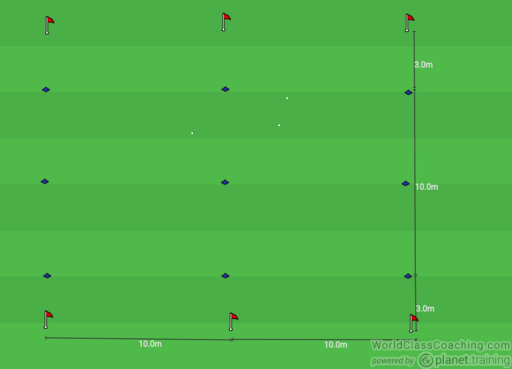
Execution:
The team in possession i.e. the attacking team, attempt to play the ball forward to break the defensive line and into the end zone players, to score.
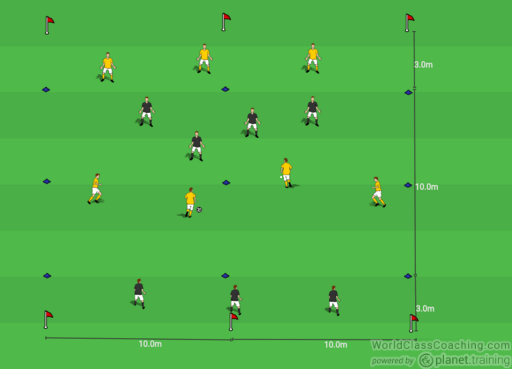
Variations:
1. The Coach feeds the ball alternatively to each team after each score.
2. The team that “score” keep possession of the ball. If the defensive team intercept the forward pass, they become the attacking team going the opposite way.
3. Restrict the number of touches of the ball e.g. central players “3 touch” and end zone players “2 touch”.
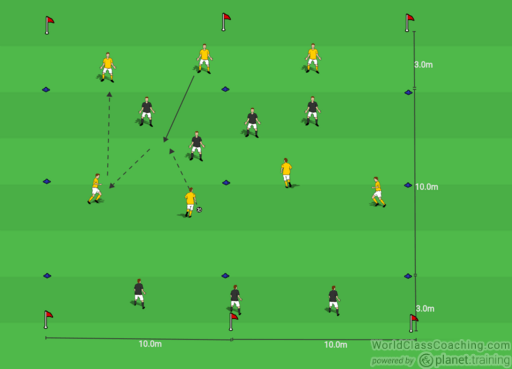
4. One player in the end zone will drop into the zone in front. Team in possession, must use this player to bounce off with a wall pass to create space for the pass to break the lines.
5. One player in the end zone player will drop into the zone in front and must receive on the half turn to dribble into the end zone to score.
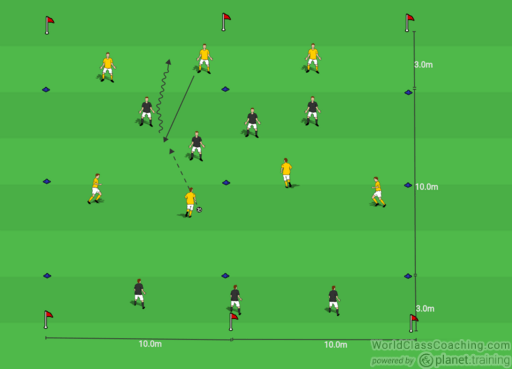

By Arthur Bell

Receiving and Turning
By Arthur Bell –
Setup:
8 players – 4 Black, 4 Yellow working in a 30 x 30 area.
4 target players round the outside of area, 4 players working in the area, as shown.
4 players inside the area with a ball each.
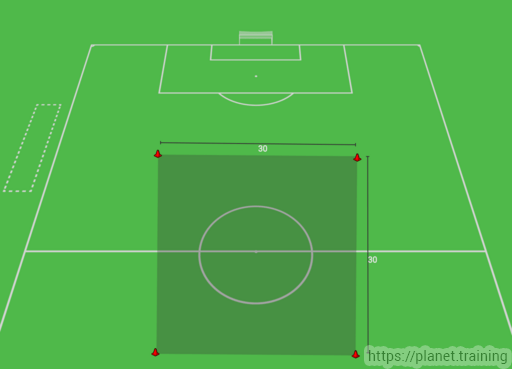
Execution:
The players in black inside the area pass to a player in black, outside the area, who pass the ball back one touch.
The players in yellow inside the area pass to a player in yellow, outside the area, who pass the ball back one touch.
Coach changes players after an allocated time.
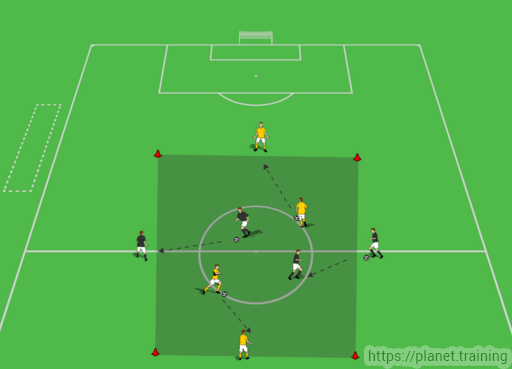
Variations:
1. Black receives from yellow, yellow receives from black.
2. Players in the middle receive side on with their back foot and play to the player on the opposite side of the grid.
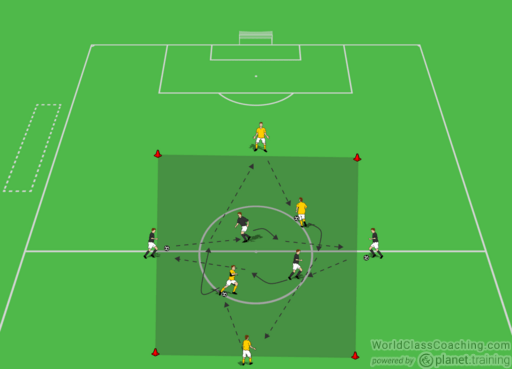
Small sided possession game
• Team that has the ball tries to keep possession.
• 2 v 2 inside the area.
• They can link up with the players on the outside.
• Players on the outside can play to other player on the outside then back in to the area.
• Players on outside have a maximum of two touches.
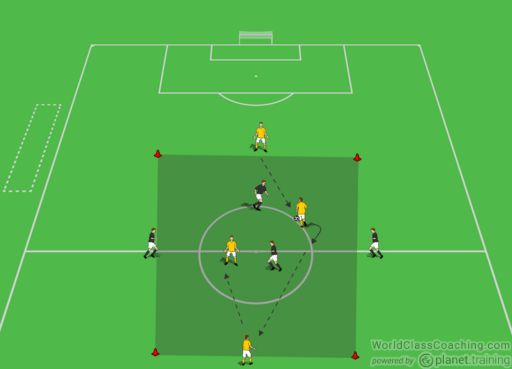

By Arthur Bell
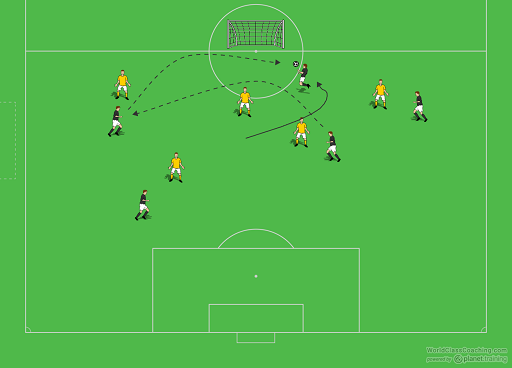
The Y Passing Drill
By Arthur Bell –
Setup:
30 m x 40 m grid. (2 grids 30 m x 20 m)
16 players.
8 players per grid.
Supply of balls at two diagonally opposite corners.

Execution:
A and A2 start at the same time.
A passes to B, B passes to C, C returns pass to B, B passes to D.
D dribbles to A2.
Players rotate A to B to C to D then across to the other group.
This is mirrored by A2, B2, C2 & D2.

Variations:
1. A and A2 start at the same time.
A passes to B, B passes to C, C returns pass to B, B passes to D.
D dribbles to 10 yards from A2 and plays a short pass.
Players rotate A to B to C to D then across to the other group.
This is mirrored by A2, B2, C2 & D2.

2. A and A2 start at the same time.
A passes to B, B passes to C, C returns pass to B, B passes to D.
D receives and plays a long pass to A2.
Players rotate A to B to C to D then across to the other group.
This is mirrored by A2, B2, C2 & D2.

By Arthur Bell
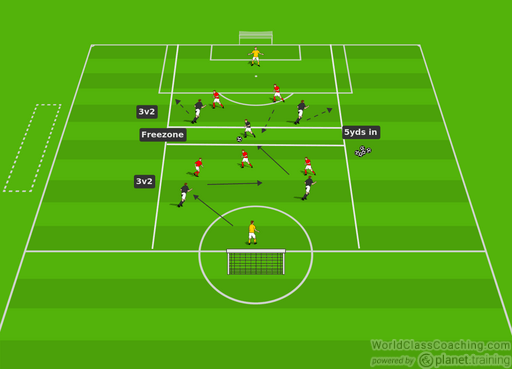
Fast Action Shooting Drill
By Arthur Bell –
Setup:
14 players – 7 Black, 7 Yellow + 2 Goal Keepers
40 x 40 outside grid
10 x 10 inside central box
2 x Goals
14 Balls
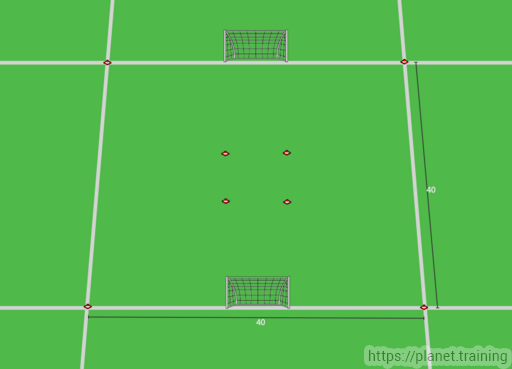
Execution:
1st player passes to player on the same side of central box.
2nd player receives, takes a touch and then shoots.
1st player follows pass to replace the receiving player.
2nd player collects ball and joins opposite line.
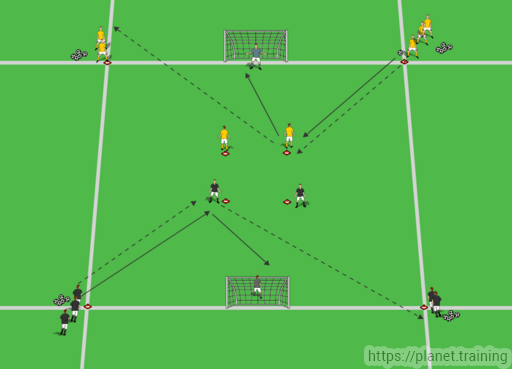
Variations:
1. 1st player chips the ball to player on the same side of central box, he then becomes a defender and confronts the 2nd player receives, who takes a touch and then shoots.
1st player follows pass to replace the receiving player.
2nd player collects ball and joins opposite line.
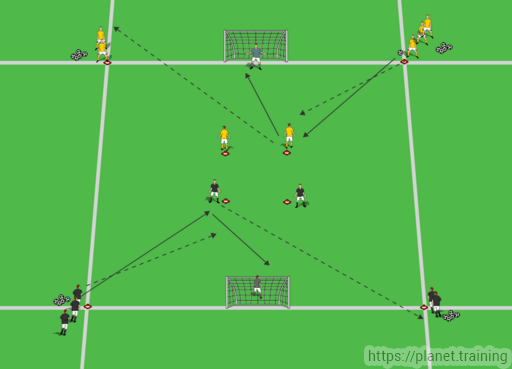
2. Diagonally opposite lines work together.
Both outside players pass to nearest central player.
Central players control and pass back to outside players.
Central players switch places and receive a chip pass from their outside player which they control and shoot, then they collect ball and join the opposite line.
Outside players become central players.
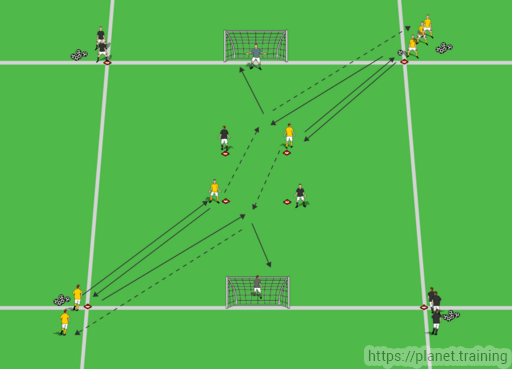
3. Diagonally opposite lines work together.
Both outside players pass to nearest central player.
Central players control and pass back to outside players.
Central players switch places and receive a chip pass from their outside player which they control and shoot, then they collect ball and join the opposite line.
Outside players come into act as defenders then become central players.
By Arthur Bell
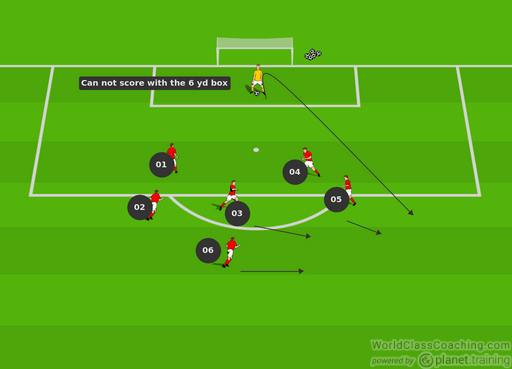
Positional Passing – Creative Movement in Wide Areas
By Arthur Bell –
Setup:
40 x 40 grid.
6 stations each with a pole/mannequin as a marker.
2/3 players at each station.
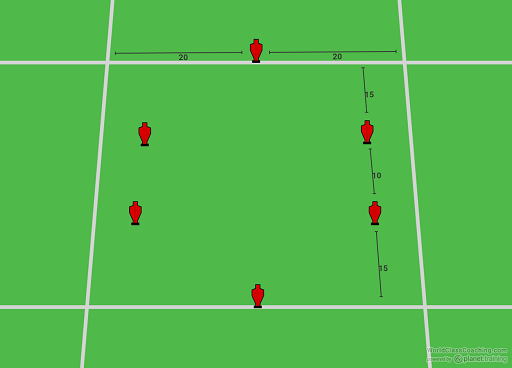
Execution:
Players work on different patterns throughout the drill which will develop, passing, movement, variation, imagination, communication etc.
Players repeat the same pattern on both sides.
Players follow their pass to the next station.
To begin, both end players pass to station 1 on the outside of the mannequin.
Station 1 player receives behind the mannequin and passes to Station 2 player on the inside the Mannequin.
Station 2 goes across the front of the mannequin to receive the ball and pass to the opposite end player.
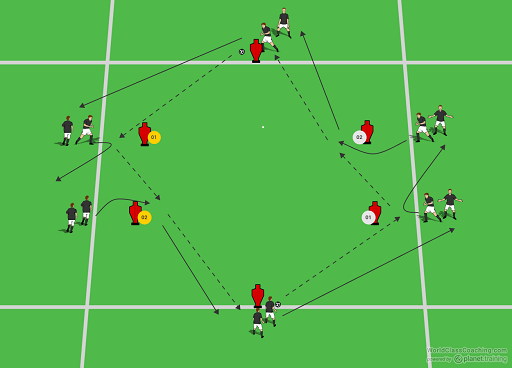
Variations:
1. Players work on opposites. If station 1 goes to outside then station 2 should go inside and vice versa.
2. End Player to Station 2, Station 2 lays off for late support run from station 1. Player then hits end station.
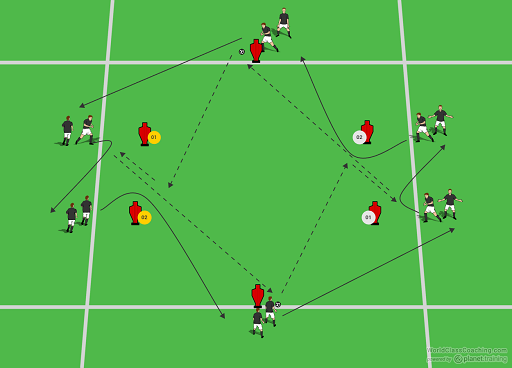
3. End Player to Station 2, player comes inside and support comes from station 1 as an overlapping run before hitting end player.
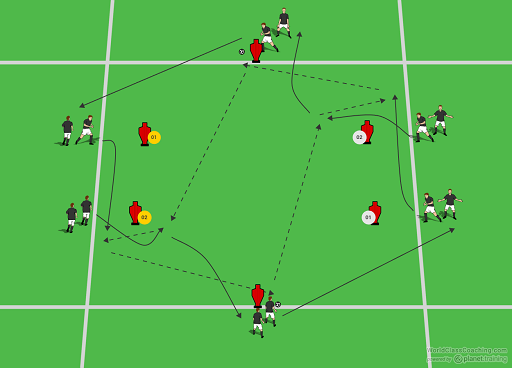
4. Coaches can work on any pattern they wish, use imagination, allow players to be creative.
By Arthur Bell
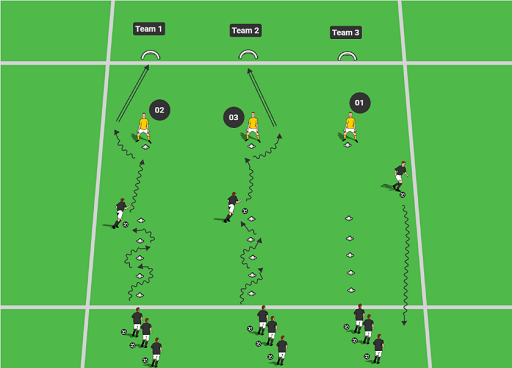
Creative Movement in Wide Areas
By Arthur Bell –
Setup:
Three channels each 12 yards wide and 28 yards in length. Two groups of players, from each group, two players on the outside, two players at the end and the remaining players at the top. Two small goals at the top and to the side as indicated.
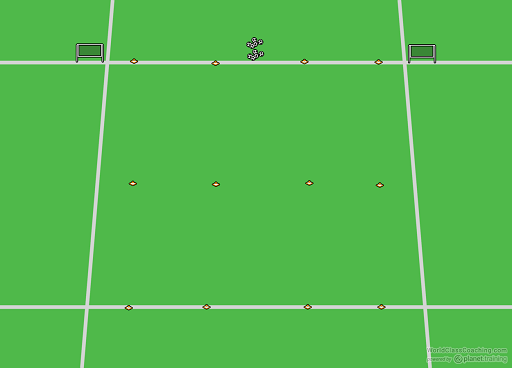
Execution:
Player 1, from the top, in each group will drive with the ball towards Player 2 at the bottom. Before reaching the midpoint, Player 1 passes to Player 2.
On receiving the ball the Player 2 moves the ball to the outside, this triggers the Player 3 to run in behind to receive a diagonal pass.
Player 3 receives and passes into the goal as quickly as possible. The players all follow their pass as the exercise repeats.
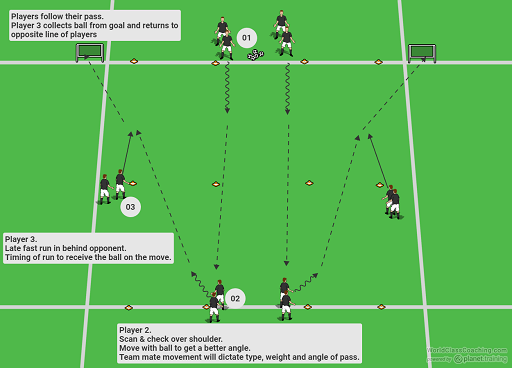
Variations:
1. On receiving the ball Player 2 moves the ball to the outside, this triggers the Player 3 to run in off the side to receive a straight pass, and then drive with the ball to the top. The players all follow their pass as the exercise repeats.
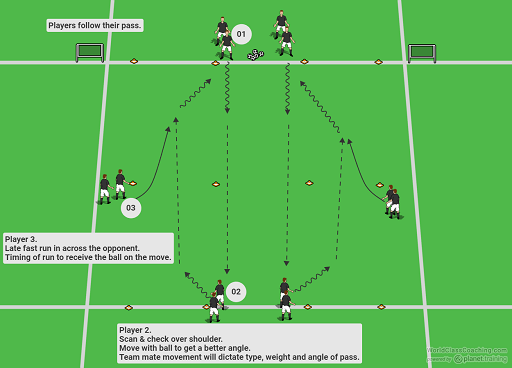
2. Add another Player 4 at the bottom outside corner of each group. On receiving the ball the Player 2 moves the ball to the outside, this triggers Player 3 to run in off the side and for the Player 4 to overlap. The Player 2 can choose to play a straight pass to the Player 3 coming in or a diagonal pass to the overlapping Player 4.
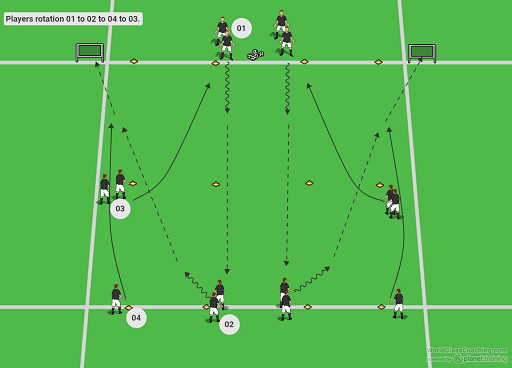
3. On receiving the ball the Player 2 moves the ball to the outside, this triggers the Player 3 to run wider and for the Player 4 underlap as required. Player 2 can choose to play a straight pass to the Player 3.
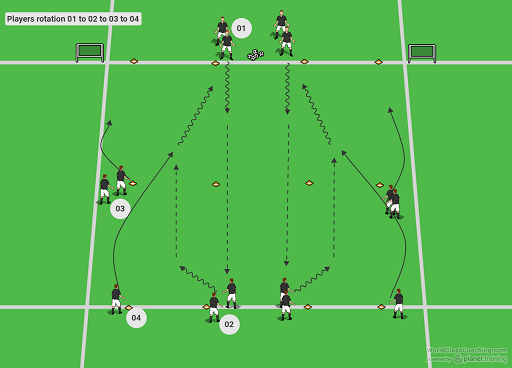
4. On receiving the ball the Player 2 moves the ball to the outside, this triggers the Player 3 to run in off the side or to run wider and for the Player 4 to overlap or underlap as required. Player 2 can choose which option to play.
By Arthur Bell

Defending an Overload
By Sean Reed –
Objective
For this session we are focusing on defending and specifically when out- numbered.
Set Up
First Part
• The area is 4 grids x 3 grids (5x5yds)
• 3 Teams
• 2 Teams of 4 players at either end and each player must remain in a grid
• 1 Team of 3 in the middle and the can travel in any of the grids in their row, not the grids in front of them
• The 2 teams at end of the area are in possession of the ball and are looking to work the ball from one end to the another
• The teams in possession are on 2 touch and the ball must remain on the ground
• A goal is scored for the defending team if they force a mistake and get contact on the ball
• The ball always starts with either of the teams at each end (team of 4 players)
• The team defending (3 players) remain in the middle for 60secs or the length of time the coach stipulates
See Diagram 1
Second Part
• Session is set up in one half of the pitch
• Pitch – (W) 30-40 yrds x (L) 30-40yds
• 4v3 (attacker v defender)
• Defending players defend 4 goals
• The ball always starts with the attacking team
• If the defending team win possession they play into the coach
• There is an offside line
Progressions
• If the defending team win possession they have the chance to score
• Limit attacking team to restricted touches
• Give the attackers a restriction on the numbers of passes they have in order to score
• Restriction of where the opposition can score from (attacking / defending half)
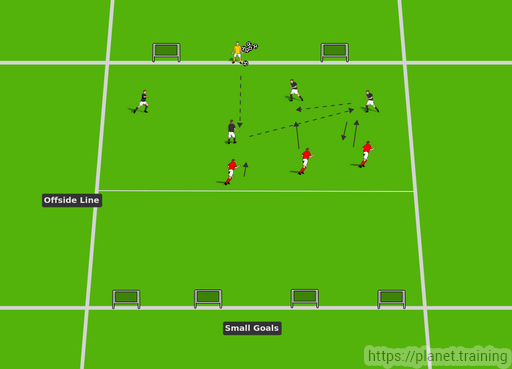
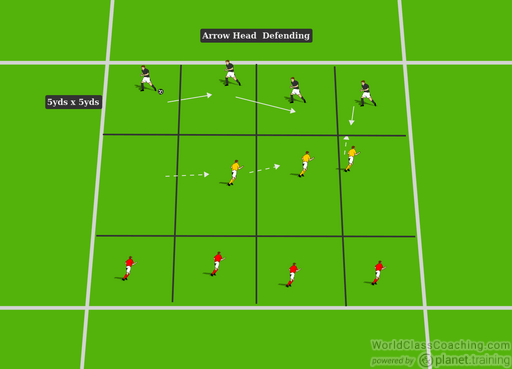
Some Coaching Points
• Traveling with the ball
• Pressure on the ball (nearest player)
• Balance, cover and screen forward pass
• Maintain distances between players
• Ball side priority
• Managing the line when defending
• Communication / organization between defenders
• Furthest player away to manage the line
By Sean Reed
Former First Team Coach of Championship team Fulham FC. Sean is a UEFA A Coach with a Masters in Sport Coaching. He has over 15 years of experience working in professional football from Academy through to First team in the Premiership and Championship.
Web – www.seanjreed.com
Twitter – @SeanJReed
